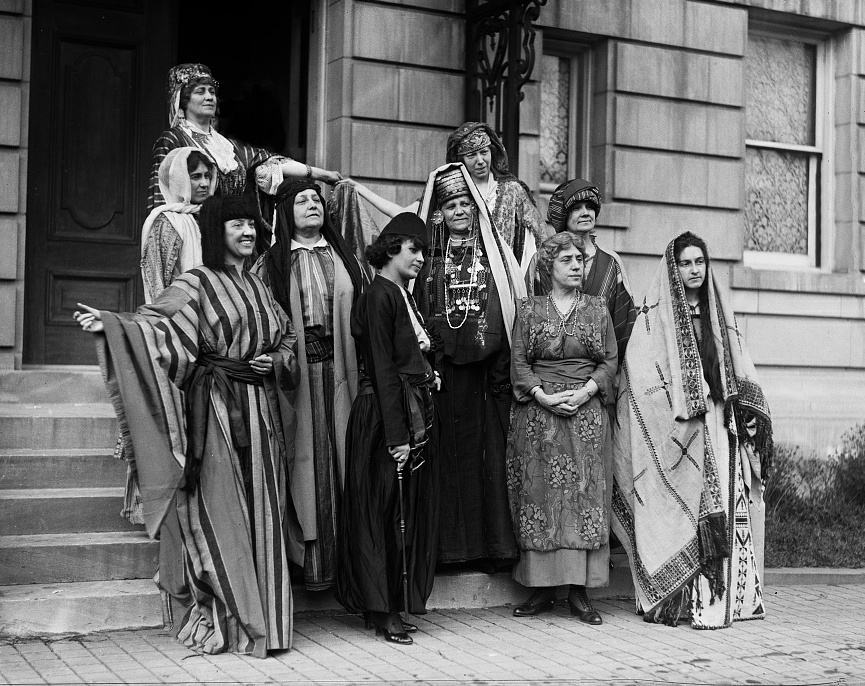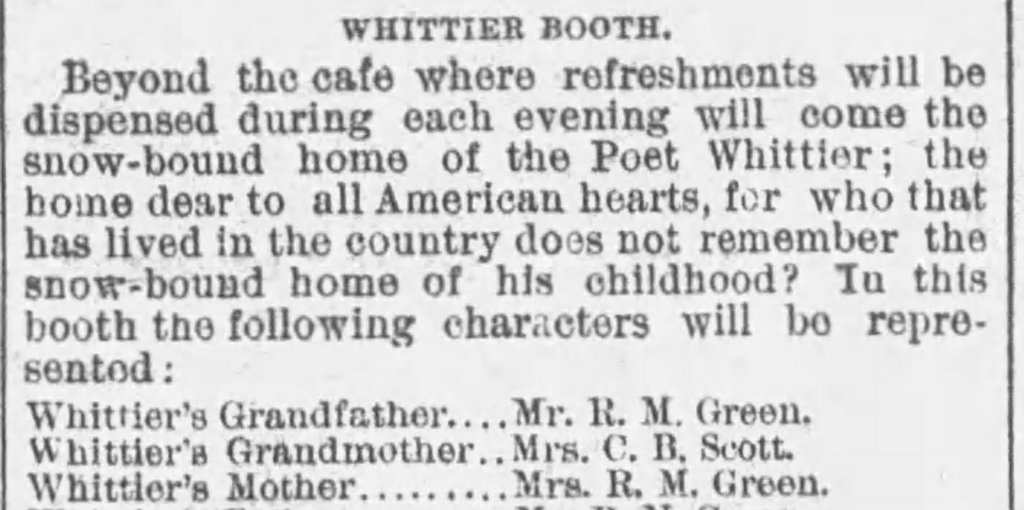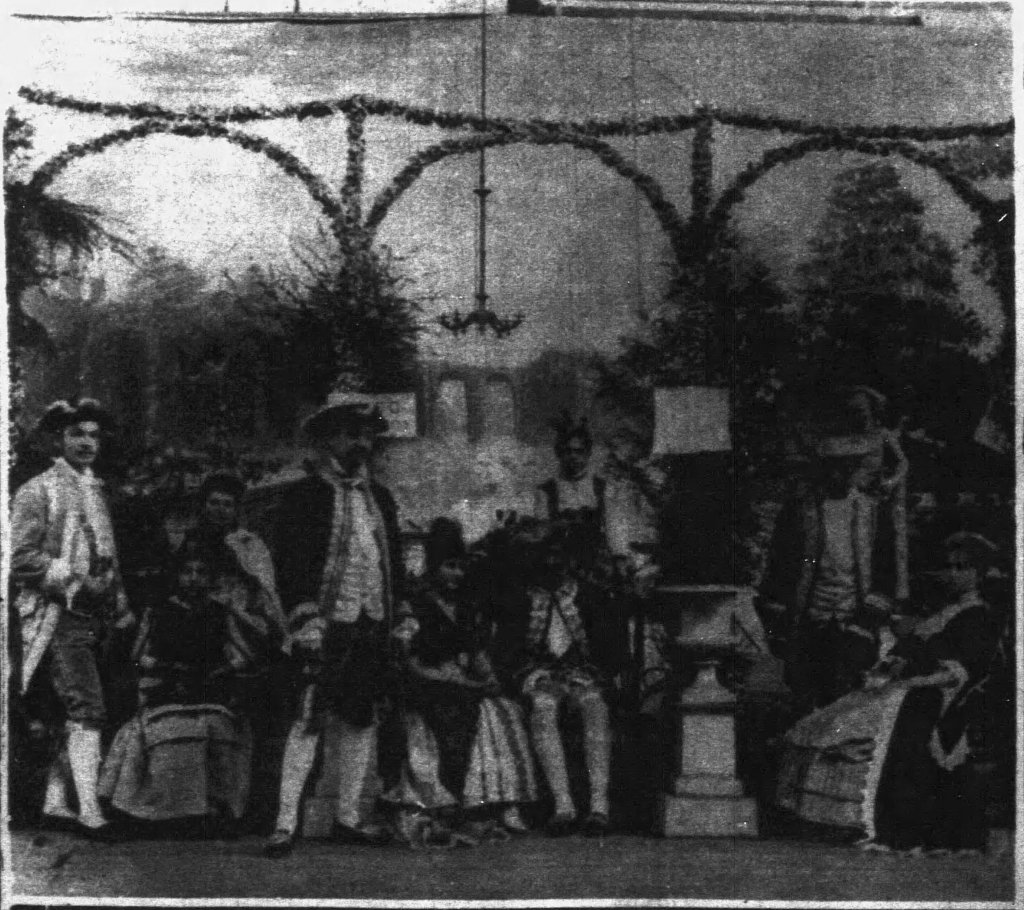In the late 1800s a new and exciting form of entertainment swept across America. It was called the Authors’ Carnival. It had all the fun of a community fair, as well as dazzling theatrics on a magnificent scale.
The Authors’ Carnival drew great crowds in every city in which it was staged, so it had to be set up in a large space, such as a town hall or tabernacle. The concept, though, was simple: the Carnival was comprised of a number of booths, each of which depicted a scene from a famous author’s works.
For example, there was a booth devoted to Twenty Thousand Leagues Under the Sea by Jules Verne. Costumed actors portrayed scenes from the book in an elaborately decorated submarine compartment behind a gauze curtain that simulated water.
Another booth was devoted to John Greenleaf Whittier’s poem, “Snow-Bound: A Winter Idyll.”
There were booths dedicated to Shakespeare, Longfellow, and Washington Irving, and many more literary figures, including Mother Goose. One of the most popular booths was lavishly decorated as Aladdin’s Cave.
In many cases, booths were set up so the costumed actors could interact with the people passing by.
The highlight of the Authors’ Carnival occurred on a center stage where tableaux vivant were enacted at intervals throughout the day and evening. The most popular tableau was the colorful, well-choreographed “The Fan Brigade.” It illustrated an essay by British satirist Joseph Addison on how ladies in the eighteenth century used their fans as weapons in flirtation and romance.
In 1881 the Authors’ Carnival arrived in Cleveland, Ohio, where sixteen-year-old Grace Livingston lived with her father Charles and mother Marcia (who was Isabella Alden’s older sister). Already an aspiring author, Grace visited the Authors’ Carnival one afternoon and wrote the following account of her experience:
The Author’s Carnival in Cleveland
By Grace
It was impossible for me to attend the evening entertainment of the Author’s Carnival, but when a matinee was announced for the next afternoon, I thought I would go.
It was held in the tabernacle. As you entered the door, directly opposite you was the stage, where the most beautiful tableaux were exhibited every twenty minutes, the performers never having rehearsed before, but being picked out and arranged on the spot, from the different booths.
The booths were ranged around the sides, and the center left for the audience to promenade. We took a look at the booths before the first tableaux.
The “Alhambra,” which, having a piano, and a few good players, managed to keep such a crowd around it all the time, that one could hardly get a peep at it.
Whittier’s “Snow Bound,” with its soft gray costumes, which harmonize wonderfully with the neat room, and fire-place, and cupboard, with its rows of bright, shining dishes, and the strings of dried apples hanging from the ceiling. Whittier’s “grandmother” happened to be a friend of mine, so I stepped up to her, and she said, “How does thee do, friend Grace?”
There was the “Arabian Nights” booth, where they sold miniature “Aladdin Lamps,” said to be exact copies from the original.
“Lalla Rookh” and the “Jules Verne” booths were beautiful and picturesque, with their mermaids, and flowers, and sea-weeds.
Longfellow’s “Hiawatha,” where the Indians flourished their tomahawks, and gave war-whoops, attracted a great deal of attention, and really was one of the most fascinating.
The “Egyptian” booth had beautiful, rich costumes.
The “Addison” booth had, perhaps, the most beautiful costumes, but the characters were all ladies.
The “Dickens” booth, with all its comical characters, was just refreshing.
As I walked up to the “Shakespeare’s” booth, the “Duke of York,” an old schoolfellow, stepped forward and shook hands with me.
The tableaux-bell rang, and we all rushed to the center of the floor, each one trying to get the best position for seeing. The most beautiful and quaint pictures succeeded each other; lastly, the beautiful “Fan Drill.” If you have never seen it, seen the perfect time and graceful motions, you cannot imagine how beautiful it was.
But there was one blight on all this beauty. At the “Spanish” booth they sold cigars and cigarettes, and some ungentlemanly persons even smoked among all that company of ladies. It was Satan’s way of joining in the Author’s Carnival.
Tableaux and theatricals were common forms of entertainment during Isabella Alden’s lifetime, and she wrote about them in several of her novels. You can read more about tableaux in these previous posts:








